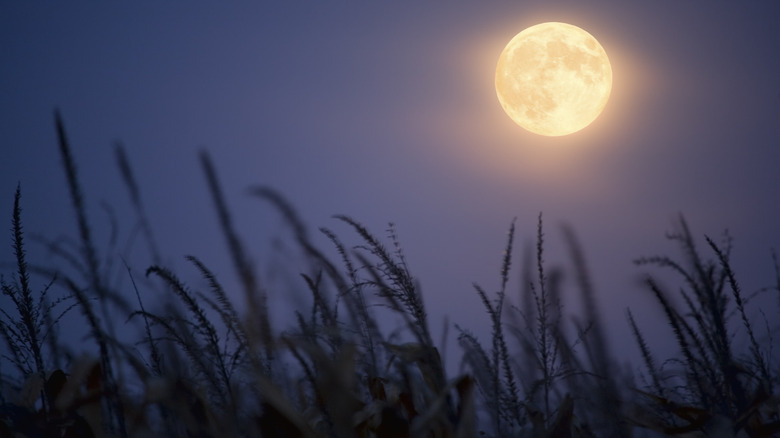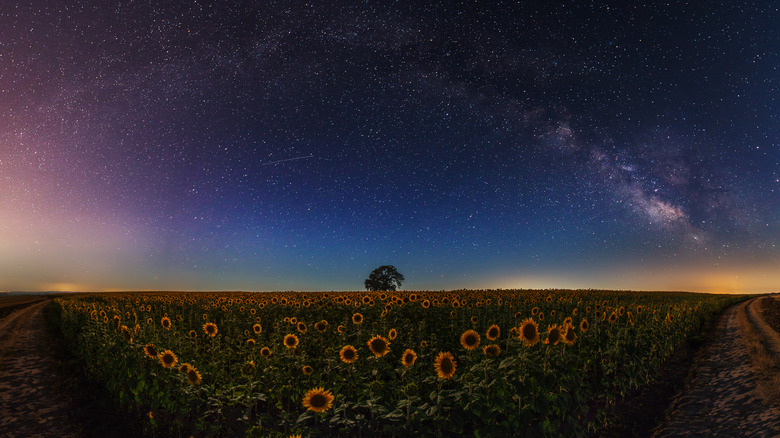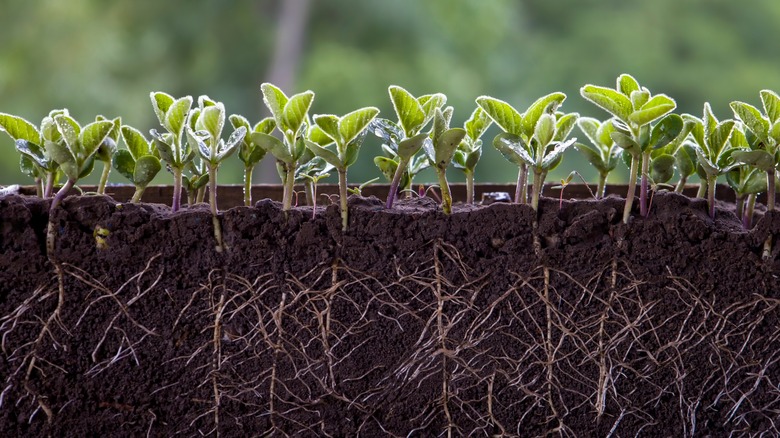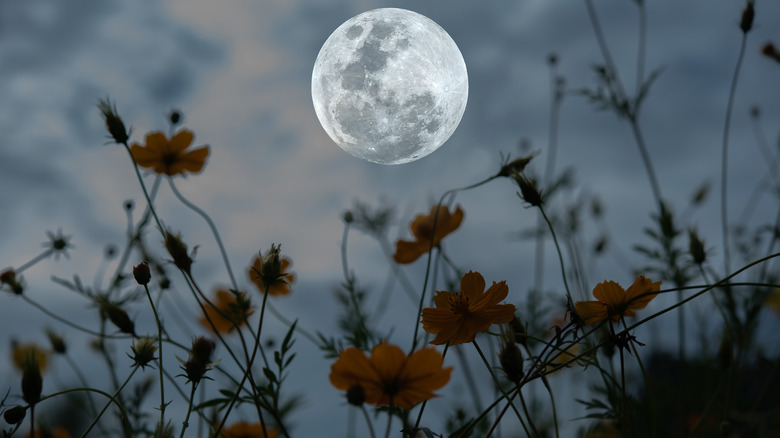Lunar Phase Gardening: Myth Or Secret To A Great Harvest?
Humans have been planting seeds for somewhere around 12,000 years, and while we're getting pretty good at it, there is still plenty of room for theories and superstitions in the gardening department. When planting, it's only weird if it doesn't work. If we can turn to pool noodles to encourage plant growth, why not look toward the moon for an increased yield? Lunar phase gardening, or moon planting, does just that. The theory is that certain crops will take root better when planted under specific moon phases. You don't actually plant seeds under the moonlight; the practice only requires that you follow a simple calendar. There are centuries of history behind this concept, and on the surface, it makes a lot of sense. The moon does affect the entire ocean, but the jury is still out on what it can do to a sunflower seed.
While gardening by the moonlight is as old as agriculture itself, modern scientific evidence says its contribution is irrelevant. The American Society of Agronomy published a research paper that found "no reliable, science-based evidence" for any connection between the moon's phases and plant physiology. Science does encourage singing to your plants, so they're clearly open to weirdness as long as it brings tangible results. So, who's right?
What is lunar phase gardening?
Lunar phase gardening is the idea that the moon's gravitational pull affects the moisture in the Earth's soil. Legend has it that the moisture in the earth is affected like the tides, so seeds will absorb more water closer to full moons and new moons. It sounds pretty simple — absorbing more water is good for plants. So, plant close to the full or empty moon and profit. Not so fast. There are layers to Lunar phase gardening that can get pretty deep.
Traditional lunar planting farmers believe that particular crops will excel during different cycles. To take advantage of the alleged gravitational pull, they developed a complete planting calendar that follows the waxing cycle (while the moon is going from new to full) and the waning cycle (when the moon is moving from full to new).
Depending on how far you want to take it, a lot of lunar phase gardening manifestos, like the Old Farmer's Almanac, also examine how the moon works with respect to the distant stars and provide Zodiac sign planting recommendations. Let's wait and see how this year's crops work under the moon phases before we start waiting for Capricorn season to plant our corn.
Plant different plants at different phases
If someone asks you to sum up lunar phase gardening in six words or less, "plant different plants at different phases" is the answer. We'll introduce you to the generalist approach, which will split moon-phase gardening into two main groups: aboveground and belowground crops. Check any specific crops you want to plant with the "New" Farmer's Almanac's Planting By the Moon Calendar to know exactly when they recommend you sow your seeds.
Aboveground crops love a waxing moon. Some sources recommend starting with your leafy greens during a waxing crescent, which is the first day after a new moon, but you definitely want to get those suckers planted by the time the moon hits its waxing gibbous phase, which is the last quarter of the cycle. Belowground crops prefer a waning moon, but you'll still want to plant them as close to the full moon as possible. Just wait until at least one day after the moon hits its peak to break ground. Lunar gardening manifestos have information for everything from the best days to plant based on the moon to the best days to quit smoking, so you don't have to worry about planning your life anymore; just consult the moon and go from there.
Is moon gardening real, or just a superstition?
The answer to that question will probably depend on who you ask. A scientist will tell you that the right blends of fertilizer and pesticides are all you need to feed a nation, but a lot of traditional farmers will tell you to plan out your entire harvest based on the moon. Working on this piece has led me to believe it's somewhere in the middle. It's realistic that the moon cycle probably does do something to plants, but it probably doesn't do everything that lunar phase gardening promises.
But what's the harm in trying? Lunar phase gardening is relatively simple. There are few mistakes to avoid and no instructions that tell you to refrain from eating or drinking for 12 hours before planting or laying out your plot in some convoluted, drastic way. The core of the idea is to plant above-ground crops on some days and root vegetables on others. The whole concept requires you to do everything you already planned on doing and nothing you didn't. The only change is which day you'd dig dirt. You can try to come at this with an open mind and think of moon-phase gardening as a potentially successful gardening tip, and if your plants don't blossom, you can always just blame the moon.
The case against lunar phase gardening
The moon has its fair share of haters. To make this piece as objective as possible, let's check out the arguments against lunar gardening. Specifically, let's examine the study we mentioned earlier that found no scientific backing to the concept of connectedness between the moon and crop growth. This 2020 paper published in Agronomy went even further, cautioning educators to "objectively address pseudo-scientific ideas and promote critical thinking."
The researchers came to this conclusion after examining historical texts that argued in favor of lunar phase gardening and poking holes in those works. One particularly solid example of this is the researcher breaking down the idea that the moon affects sap flow in trees. The paper explained that if the moon did affect sap flow in the same way it affects the tides, we would see the sap flow change twice a day, and we do not. Counterargument: just because the moon doesn't affect sap flow doesn't mean it can't help your crops grow.
To examine that particular front, the researchers' literature review looked at previous plant-based publications that argued for and against lunar gardening. Their conclusion was that no one could bring concrete evidence of the moon actually affecting plant growth, which is not a great result for lunar gardeners. Still, this paper alone isn't enough to squash tradition. A passionate moon gardener might argue that the researchers didn't actually plant anything, they just read old papers, and you don't grow crops in books.
It's your garden, you can do what you want
Gardening requires heaps of resources. There are the physical resources required for a successful harvest — the books, texts, and classes that promise to help your garden blossom, and now, there's an entire internet full of gardening tips that range from weed-killing sugar hacks to viral Tik-Tok trends. It's up to you to explore all the resources at your disposal, stick with what works, and be quick to move on from what doesn't. Moon phase gardening is no different. Scientific studies have helped us lower our expectations of what the moon can actually deliver, but first-hand accounts and centuries of practice say it's still worth a shot.
One particular success story, posted on the Moon Gardening Calendar, really helped to sum up the tangible benefits that planting by the moon can have. It comes from Rose Nolan, a plant nursery professional who swears by the practice. As a part of her four-paragraph success story, one sentence really stood out. Rose claimed, "I feel that I am a bit better organized as I push myself to get gardens prepared and ready to plant on the first days possible." That is a beautiful aspect of moon-phase gardening. The practice can help you schedule out your garden. If you commit to planting your bulbs before the next full moon, that deadline can be the push you need to finally plant. No matter how you decide to plant, ultimately, you can grow your own way.





